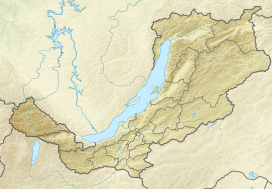Khamar-Daban
| Khamar-Daban | |
|---|---|
| Russian: Хама́р-Даба́н / Buryat: Һамар дабаан | |
 Landscape of the range | |
| Highest point | |
| Peak | |
| Elevation | 2,396 m (7,861 ft) |
| Dimensions | |
| Length | 420 km (260 mi) E/W |
| Width | 65 km (40 mi) N/S |
| Geography | |
 Location in Buryatia, Far Eastern Federal District, Russia | |
| Country | Russia |
| Federal subject | Buryatia and Irkutsk Oblast |
| Range coordinates | 51°25′N 104°30′E / 51.417°N 104.500°ECoordinates: 51°25′N 104°30′E / 51.417°N 104.500°E |
| Parent range | South Siberian System |
| Borders on | Eastern Sayan |
| Geology | |
| Type of rock | Slate, gneiss, basalt, limestone and granite intrusions |
| Climbing | |
| Easiest route | From Gusinoozyorsk |
Hamar-Daban (Russian: Хама́р-Даба́н; Buryat: Һамар дабаан, from hамар - "nut", and дабаан, "pass" or "ridge"), is a mountain range in Southern Siberia, Russia.
Geography[]
The range is located in Buryatia, with a small section in Irkutsk Oblast. It rises near the Baikal Mountains not far from Lake Baikal. It forms a geographic prolongation of the Sayan Mountains.[1] The highest peak is at 2,396 m (7,861 ft); 2,090 m (6,860 ft) high Chersky Peak is another important summit.[2] The southern end of the range is part of the Selenga Highlands.[3] The climate of the northern part of the range is affected by Lake Baikal, being temperate and humid, with precipitation up to 1,300 mm per year. The average January temperature is -16-18 °C.[4]

In popular culture[]
The song of the same name by Yuri Vizbor, written in 1962, is dedicated to the range.
1993 incident[]
Six members of a seven-person hiking group led by Lyudmila Korovina died in mysterious circumstances in 1993.[5] Valentina Utochenko was the only survivor.[6] Later autopsies found signs of hypothermia and protein deficiency in the deceased members of the hiking group.[7]
See also[]
References[]
- ^ Kozhov, M. (2013-11-11). Lake Baikal and Its Life. Springer Science & Business Media. p. 7. ISBN 9789401573887.
- ^ Природа Байкала - вершина Пик Черского (in Russian)
- ^ Natalʹi︠a︡ Vasilʹevna Fadeeva, Селенгинское среднегорье: природные условия и районирование (Selenga Highlands: Natural Conditions and Zoning) Buryat Book Publishing House, 1963 - Physical geography - 169 pages, (in Russian)
- ^ Sinyukovich VN; Chumakova EV (2009). "Современные особенности гидрометеорологического режима южного побережья оз. Байкал" [Modern features of the hydrometeorological regime of the southern coast of Lake Baikal] (PDF). Bulletin of Irkutsk State University (in Russian). 2 (2): 117–133. Archived from the original (PDF) on 2 October 2013.
- ^ Buryatia Incident: Russia's other Dyatlov Pass. 20 November 2019. Retrieved 14 January 2021.
- ^ Natalia Varsegova (24 July 2018). "Что произошло на бурятском "перевале Дятлова"" [What happened at the Buryat "Dyatlov pass"]. Komsomolskaya Pravda (in Russian). Retrieved 14 January 2021.
- ^ Oleg Yegorov (25 February 2019). "Beyond the Dyatlov mystery: 2 other creepy tragedies in the Russian mountains". Beyond Russia. Retrieved 14 January 2021.
External links[]
 Media related to Khamar-Daban at Wikimedia Commons
Media related to Khamar-Daban at Wikimedia Commons
- Mountain ranges of Russia
- Landforms of Siberia
- Landforms of Buryatia
- Landforms of Irkutsk Oblast
- Siberia geography stubs
- Buryatia geography stubs
- Buryatia stubs

